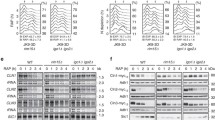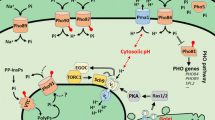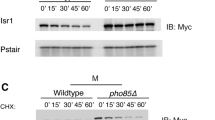Abstract
The Saccharomyces cerevisiae SLK1 protein is implicated in nutrient sensing and growth control. Under nutrient-limiting conditions, slk1 mutants fail to undergo cell cycle arrest. The role of the SLK1 protein in nutrient sensing was examined with respect to the cAMP-dependent protein kinase (PKA) pathway, which has a well characterized role in growth control in yeast, and by the analysis of dominant SLK1 alleles that affect the nutrient response of wild-type cells. Interactions with the PKA pathway were examined by phenotypic analysis of double mutants of slk1 and various PKA pathway mutants. Combining the slk1-Δ mutation with a mutation that is thought constitutively activate the PKA pathway, pde2, resulted in enhanced growth control defects. The combination of slk1-Δ with mutations that inhibit the PKA pathway, cdc25 and ras1 ras2, failed to alleviate the slk1 cell cycle arrest defect and lowered the permissive temperature for growth. Furthermore bcy1 tpk1 tpk2 tpk3 w (bcyl tpk w) mutants, which have constitutive, low-level, cAMP-independent kinase activity, exhibit nutrient sensing, which is eliminated in the slk1 bcy1 tpk w mutants. These results implicated SLK1 in PKA-independent growth control in yeast. The amino-terminal, noncatalytic region of the SLK1 protein may be important in the regulation of SLK1 function in growth control. Overexpression of this region caused starvation sensitivity in wild-type cells by interfering with SLK1 protein function.
Similar content being viewed by others
References
Aelst LV, Barr M, Marcus S, Polverino A, Wigler M (1993) Complex formation between RAS and RAF and other protein kinases. Proc Natl Acad Sci USA 90:6213–6217
Ahn NG, Seger R, Krebs EG (1992) The mitogen-activated protein kinase activator. Curr Opin Cell Biol 4:992–999
Anderson NG, Maller JL, Tonks NK, Sturgill TW (1990) Requirement for integration of signals from two distinct phosphorylation pathways for activation of MAP kinase. Nature 343:651–653
Arkinstall SJ, Papasavvas SG, Payton MA (1991) Yeast alpha mating factor receptor-linked G-protein signal transduction suppresses Ras-dependent activity. FEBS Lett 284:123–128
Boguslawski G (1992) PBS2, a yeast gene encoding a putative protein kinase, interacts with the RAS2 pathway and affects osmotic sensitivity of Saccharomyces cerevisiae. J Gen Microbiol 138: 2425–2432
Boguslawski G, Polazzi JO (1987) Complete nucleotide sequence of a gene conferring polymyxin B resistance on yeast: similarity of the predicted polypeptide to protein kinases. Proc Natl Acad Sci USA 84:5848–5852
Brewster JL, Valoir TD, Dwyer ND, Winter E, Gustin MC (1993) An osmosensing signal transduction pathway in yeast. Science 259:1760–1763
Broach JR (1991) RAS genes in Saccharomyces cerevisiae: signal transduction in search of a pathway. Trends Genet 7:28–33
Broach JR, Deschenes RJ (1990) The function of RAS genes in Saccharomyces cerevisiae. Adv Cancer Res 54:79–139
Broek D, Toda T, Michaeli T, Levin L, Birchmeier C, Zoller M, Powers S, Wigler M (1987) The S. cerevisiae CDC25 gene product regulates the RAS/adenylate cyclase pathway. Cell 48:789–799
Cairns BR, Ramer SW, Kornberg RD (1992) Order of action of components in the yeast pheromone response pathway revealed with a dominant allele of the STE11 kinase and the multiple phosphorylation of the STE7 kinase. Genes Dev 6:1305–1318
Cameron S, Levin L, Zoller M, Wigler M (1988) cAMP-independent control of sporulation, glycogen metabolism, and heat shock resistance in S. cerevisiae. Cell 53:555–566
Camonis, J. Kalekine M, Gondre B, Garreau H, Boy-Marcotte E, Jacquet M (1986) Characterization, cloning and sequence analysis of the CDC25 gene which controls the cyclic AMP level of Saccharomyces cerevisiae. EMBO J 5:375–380
Celenza J, Carlson M (1986) A yeast gene that is essential for release from glucose repression encodes a protein kinase. Science 233:1175–1180
Chen D-C, Yang B-C, Kuo T-T (1992) One step-transformation of yeast in stationary phase. Curr Genet 21:83–84
Costigan C, Gehrung S, Synder M (1992) A synthetic lethal screen identifies SLK1, a novel protein kinase homolog implicated in yeast cell morphogenesis and cell growth. Mol Cell Biol 12:1162–1178
Garret S, Broach J (1989) Loss of Ras activity in Saccharomyces cerevisiae is suppressed by disruptions of a new kinase gene, YAK1, whose product may act downstream of the cAMP-dependent protein kinase. Genes Dev 3:1336–1348
Granot D, Snyder M (1991) Glucose induces CAMP-independent growth-related changes in stationary-phase cells of Saccharomyces cerevisiae. Proc Natl Acad Sci USA 88:5724–5728
Hanks SK, Quinn AM (1991) Protein kinase catalytic domain sequence database: identification of conserved features of primary structure and classification of family members. Methods Enzymol 200:38–81
Hartwell LH, Mortimer RK, Culotti J, Culotti M (1973) Genetic control of the cell division cycle in yeast: V. Genetic analysis of cdc mutants. Genetics 74:267–286
Henikoff S (1987) Unidirectional digestion with exonuclease III in DNA sequence analysis. Methods Enzymol 155:156–165
Hubbard E, Yang X, Carlson M (1992) Relationship of cAMP-dependent protein kinase pathway to SNF1 protein kinase and invertase expression in Saccharomyces cerevisiae. Genetics 130:71–80
Irie K, Takase M, Lee K, Levin D, Araki H, Matsumoto K, Oshima Y (1993) MKK1 and MKK2, which encode Saccharomyces cerevisiae mitogen-activated protein kinase-kinase homologs, function in the pathway mediated by protein kinase C. Mol Cell Biol 13:3076–3083
Ito H, Fukuda Y, Murata K, Kimura A (1983) Transformation of intact yeast cells treated with alkali cations. J Bacteriol 153:163–168
Johnston M, Davis RW (1984) Sequences that regulate the divergent GAL1-GAL10 promoter in Saccharomyces cerevisiae. Mol Cell Biol 4:1440–1448
Jones S, Vignais M, Broach J (1991) The CDC25 protein of Saccharomyces cerevisiae promotes exchange of guanine nucleotides bound to Ras. Mol Cell Biol 11:2641–2646
Kataoka T, Powers S, Cameron S, Fasano O, Goldfrab M, Broach J, Wigler M (1985) Functional homology of mammalian and yeast RAS genes. Cell 40:19–26
Lai C, Boguski M, Broek D, Powers S (1993) Influence of guanine nucleotides on complex formation between Ras and CDC25 proteins. Mol Cell Biol 13:1345–1352
Lee K, Levin D (1992) Dominant mutations in a gene encoding a putative protein kinase (BCK1) bypass the requirement for a Saccharomyces cerevisiae protein kinase C homolog. Mol Cell Biol 12:172–182
Lee K, Irie K, Gotoh Y, Watanabe Y, Araki H, Nishida E, Matsumoto K, Levin D (1993) A yeast mitogen-activated protein kinase homolog (Mpklp) mediates signalling by protein kinase C. Mol Cell Biol 13:3067–3075
Leevers S, Marshall C (1992) Activation of extracellular signalregulated kinase, ERK2, by p21ras oncoprotein. EMBO J 11:569–574
Lillie SH, Pringle JR (1980) Reserve carbohydrate metabolism in Saccharomyces cerevisiae: responses to nutrient limitation. J Bacteriol 143:1384–1394
Matsumoto K, Uno I, Ishikawa T (1985) Genetic analysis of the role of cAMP in yeast. Yeast 1:15–24
Mazzoni C, Zarzov P, Rambourg A, Mann C (1993) The SLT2/MPK1 MAP kinase homolog is involved in polarized cell growth in Saccharomyces cerevisiae. J Cell Biol 123:1821–1833
Mendenhall MD, Richardson HE, Reed SI (1988) Dominant negative protein kinase mutations that confer a G1 arrest phenotype. Proc Natl Acad Sci USA 85:4426–4430
Munder T, Mink M, Kuntzel H (1988) Domains of the Saccharomyces cerevisiae CDC25 gene controlling mitosis and meiosis. Mol Gen Genet 214:271–277
Nadin-Davis S, Nasim A (1988) A gene which encodes a predicted protein kinase can restore some functions of the ras gene in fission yeast. EMBO J 7:985–993
Nadin-Davis S, Nasim A (1990) Schizosaccharomyces pombe ras1 and bry1 are functionally related genes of the ste family that affect starvation-induced transcription of mating-type genes. Mol Cell Biol 10:549–560
Neiman A, Stevenson BJ, Xu HP, Sprogue GF, Herskowitz I, Wigler M, Marcus S (1993) Functional homology of. protein kinases required for sexual differentiation in Schizosaccharomyces pombe and Saccharomyces cerevisiae suggests a conserved signal transduction module in eukaryotic organisms. Mol Biol Cell 4:107–120
Park E, Finley D, Szostak JW (1992) A strategy for the generation of conditional mutations by protein destabilization. Proc Natl Acad Sci USA 89:1249–1252
Payne DM, Rossomando AJ, Martino P, Erickson AK, Jeng-Horng H, Shabanowitz J, Hunt DF, Weber MJ, Sugill TW (1991) Identification of the regulatory phosphorylation sites in pp42/mitogen-activated protein kinase (MAP kinase). EMBO J 10:885–892
Pelech S, Sanghera J (1992a) MAP kinases: charting the regulatory pathways. Science 257:1355–1356
Pelech S, Sanghera J (1992b) Mitogen-activated protein kinases: versatile transducers for cell signaling. Trends Biochem Sci 17:233–238
Powers S, Kataoka T, Fasano O, Goldfarb M, Strathern J, Broach J, Wigler M (1984) Genes in S. cerevisiae encoding proteins with domains homologous to the mammalian ras proteins. Cell 36:607–612
Pringle JR, Hartwell LH (1981) The Saccharomyces cerevisiae cell cycle. In: The molecular biology of the yeast Saccharomyces: life cycle and inheritance. Cold Spring Harbor Laboratory Press, Cold Spring Harbor, New York, pp 97–142
Robinson LC, Gibbs JB, Marshall MS, Sigai IS, Tatchell K (1987) CDC25: a component of the RAS-adenylate cyclase pathway in Saccharomyces cerevisiae. Science 235:1218–1221
Rossomando A, Wu J, Weber M, Sturgill TW (1992) The phorbol ester-dependent activator of the mitogen-activated protein kinase p42mapk is a kinase with specificity for the threonine and tyrosine regulatory sites. Proc Natl Acad Sci USA 89:5221–5225
Rothestein R (1983) One-step gene disruption in yeast. Methods Enzymol 101:202–211
Saiki RK, Sharf S, Faloona F, Mullis KB, Horn GT, Erlich HA, Arnhein N (1985) Enzymatic amplification of β-globin genomic sequences and restriction site analysis for diagnosis of sickle cell anemia. Science 230:1350–1354
Saiki RK, Gelfand DH, Stoffel S, Sharf SJ, Higuchi R, Horn GT, Mullis KB, Erlich HA (1988) Primer-directed enzymatic amplification of DNA with a thermostable DNA polymerase. Science 239:487–494
Sambrook J, Fritsch EF, Maniatis T (1989) Molecular cloning: a laboratory manual. Cold Spring Harbor Laboratory Press, Cold Spring Harbor, New York
Sanger F, Nicklen S, Coulson AR (1977) DNA sequencing with chain-terminating inhibitors. Proc Natl Acad Sci USA 74:5463–5467
Sass P, Field J, Nikawa J, Toda T, Wigler M (1986) Cloning and characterization of the high-affinity cAMP phosphodiesterase of Saccharomyces cerevisiae. Proc Natl Acad Sci USA 83:9303–9307
Sherman F, Fink G, Hicks J (1986) Methods in yeast genetics. Cold Spring Harbor Laboratory Press, Cold Spring Harbor, New York
Sikorski R, Hieter P (1989) A system of shuttle vectors and yeast host strains designed for efficient manipulation of DNA in Saccharomyces cerevisiae. Genetics 122:19–27
Soderling TR (1990) Protein kinases: regulation by autoinhibitory domains. J Biol Chem 265:1823–1826
Stevenson BJ, Rhodes N, Errede B, Sprague GF (1992) Constitutive mutants of the protein kinase STE11 activate the yeast pheromone response pathway in the absence of the G protein. Genes Dev 6:1293–1304
Tan JC, Nocka K, Ray P, Traktman P, Besmer P (1990) The dominant W 42 spotting phenotype results from a missense mutation in the c-kit receptor kinase. Science 247:209–212
Tatchell K, Robinson LC, Breitenbach M (1985) RAS2 of Saccharomyces cerevisiae is required for gluconeogenic growth and proper response to nutrient limitation. Proc Natl Acad Sci USA 82:3785–3789
Thomas G (1992) MAP kinase by any other name smells just as sweet. Cell 68:3–6
Thompson-Jaeger S, Francois J, Gaughran J, Tatchell K (1991) Deletion of SNF1 affects the nutrient response of yeast and resembles mutations which activate the adenylate cyclase pathway. Genetics 129:697–706
Toda T, Cameron S, Sass P, Zoller M, Scott JD, McMullen B, Hurwitz M, Krebs EG, Wigler M (1987) Cloning and characterization of BCY1, a locus encoding a regulatory subunit of the cyclic AMP-dependent protein kinase in Saccharomyces cerevisiae. Mol Cell Biol 7:1371–1377
Toda T, Shimanuki M, Yanagida M (1991) Fission yeast genes that confer resistance to staurosporine encode an AP-1 like transcription factor and a protein kinase related to the mammalian ERK1/MAP2 and budding yeast FUS3 and KSS1 kinases. Genes Dev 5:60–73
Toda T, Uno I, Ishikawa T, Powers S, Kataoka T, Broek D, Cameron S, Broach J, Matsumoto K, Wigler M (1985) In yeast, RAS proteins are controlling elements of adenylate cyclase. Cell 40:27–36
Torres L, Martin H, Garcia-Saez MI, Arroyo J, Molina M, Sanchez M, Nombela C (1991) A protein kinase gene complements the lytic phenotype of Saccharomyces cerevisiae lyt2 mutants. Mol Microbiol 5:2845–2854
Vries-Smits Ade, Burgering B, Leevers S, Marshall C, Bos J (1992) Involvement of p21ras in activation of extracellular signal-regulated kinase 2. Nature 357:602–604
Wang Y, Xu H-P, Riggs M, Rogers L, Wigler M (1991) byr2, a Schizosaccharomyces pombe gene encoding a protein kinase capable of partial suppression of the ras1 mutant phenotype. Mol Cell Biol 11:3554–3563
Whiteway M, Szostak JW (1985) The ARD1 gene of yeast functions in the switch between the mitotic cell cycle and alternate developmental pathways. Cell 43:483–492
Wilson R, Tatchell K (1988) SRA5 encodes the low-K m cyclic AMP phosphodiesterase of Saccharomyces cerevisiae. Mol Cell Biol 8:505–510
Wu J, Harrison JK, Vincent LA, Haystead C, Haystead T, Michel H, Hunt DF, Lynch KR, Sturgill TW (1993) Molecular structure of a protein-tyrosine/threonine kinase activating p42 mitogen-activated protein (MAP) kinase: MAP kinase kinase. Proc Natl Acad Sci USA 90:173–177
Author information
Authors and Affiliations
Additional information
Communicated by C. Hollenberg
Rights and permissions
About this article
Cite this article
Costigan, C., Snyder, M. SLK1, a yeast homolog of MAP kinase activators, has a RAS/cAMP-independent role in nutrient sensing. Molec. Gen. Genet. 243, 286–296 (1994). https://doi.org/10.1007/BF00301064
Received:
Accepted:
Issue Date:
DOI: https://doi.org/10.1007/BF00301064




